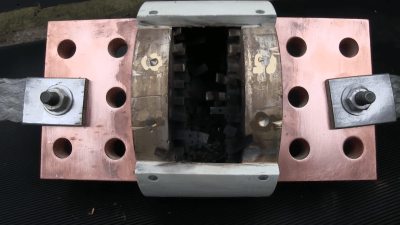Fuses are generally there to stop excessive electrical currents from damaging equipment or people’s soft, fleshy bodies when faults occur. However, some people like to blow them just for fun, and [Photonicinduction] is just one of those people. He recently decided to push the boat out, setting his mind to the task of popping a 5000 A fuse in his own back yard. (Video, embedded below.)

It’s not a job for the faint-hearted. The fuse is rated at 5,000 A — that’s the nominal rating for the currents at which it is intended to operate. Based on the datasheet, the part in question is capable of withstanding 30,000 A for up to five full seconds. To pop the fuse instantly takes something in the realm of 200,000 A.
To achieve this mighty current, a capacitor bank was built to dump a huge amount of energy through the fuse. Built out of ten individual capacitor units wired up in parallel, the total bank comes in at 10,000 μF, and is capable of delivering 200,000 A at 3000 V. (Just not for very long.) The bank was switched into circuit with the fuse via a pneumatic switch rated at just 12,000 A.
The results are ferocious, with both the fuse and switch contacts blasting out hot metal and flashes of light when the power is dumped. It’s a heck of a display. We’ve featured big capacitor banks before too, though they pale in comparison to what we’ve seen here today.
[Thanks to B1tbang3r for the tip!]
















Insanely insane insanity here!
I love it :D
Gotta love the narrators voice. That really adds to the sheer madness here.
I like how they open up the case of the fuse and remove the sand filling, that would otherwise suppress arcing. I guess, If you’re going to blow a 5000 A fuse, why not do it with some style.
Arcing, but also the sand is thermally conductive, so it changes the time constant of the fuse. It is kinda cheating to remove the sand… or hacky, perfect for hack-a-day
Nice to see our carpet guy back ;)
Seeing only the title started me thinking: “I wonder what Photonicinduction is up to these days, haven’t heard from him in a while”. Now we know.
Keep in mind: This guy knows bloody well what he is doing. Just like electroboom he just plays the fool on youtube.
Right, this project is very deep into “don’t try this at home” territory. 200kA won’t just kill, it’d vaporize fools who tries this.
45 kilojoules? sha-ZAM! Surprising any electronics still functioning within 50 yards. Wow
Was just thinking, if you dump 45kJ in under 37.2 usec, you’d exceed 1.21 GW
*clears throat*
“Great Scott!”
Great to see that the legend is back again!
Am I the only one who is a little disappointed to learn that a 5000A fuse is really just 50 100A fuses?
I’d be curious to know if they can pretty much just wire them up in parallel and go; or if there’s a surprisingly fiddly design and/or tight tolerances required to keep the little fuses from deviating from idealized-resistors-in-parallel behavior and potentially causing circumstances where the fuse as a whole shouldn’t blow; but in fact one or more of the small fuses has blown and the whole assembly will no longer perform as rated in the future.
It’s probably less bad than LEDs in parallel, since at least you’ve got a positive thermal coefficient of resistance rather than the usual thermal runaway and death if LEDs aren’t matched just so; but I assume that 5000A fuses are used in applications rather more important than shoddy LED arrays; so if the problem does exist it would be of greater concern.
This fuse is intended to protect power sources that can provide angry pixies at nearly 5000A, not a pulse from a cap bank. If this were tripped in actual service, then the remaining links would be burnt too, just slightly later than others. It probably didn’t help that he drained the sand, which keeps the links parallel as they burn rather than throwing around shrapnel that could temporarily close the fuse after it blows.
It would end up being a cascading effect that makes your fuse rated for lower amperage as each link blew. Eventually they’d all blow if power was left applied long enough.
Have to wonder what this does in applications where a brief overload popped a couple links and the overload situation went away and now you have a 5000a fuse that can only support say 3000a. There is no outward indication of how many of the links may be intact, and really no way to test it without just blowing the fuse.
Then it just sits there still in service where some load under the max rating makes it eventually blow, then you have a tech looking for an issue that blew the fuse that doesn’t actually exist.
The sand isn’t there to keep shrapnel from being thrown around in the fuse. It’s there to kill the arc in high power applications. Otherwise your popped fuse turns into an arc discharge lamp.
Very nice that someone wasted all that time doing this, so in turn I could waste my time watching it. Not really a waste though, I enjoyed it!
Oh man, that’s made my day.
Thanks B1tbang3r
“The only thing with that kind of energy is a bolt of lightning. But we never know when or where it’s going to strike”
Great crazy video !
Molten bits of metal flying everywhere in, what seems to be smallish, back yard. His neighbors must love him, hahaha.
In yesterday’s video he passed about 1000 amps through a large kitchen knife and a lawn mower blade. They got a little bit hot. In a carpeted attic. Insane. About the level of Ingegza’s rocket engine experiments in his attic. It’s nice to have Photonicinduction back!
“Fuses are generally there to stop excessive electrical currents from damaging equipment or people’s soft, fleshy bodies when faults occur.”
No. Fuses are intended to interrupt fault current for the principle purpose of fire hazard mitigation.
Fire causes damage to both equipment and people’s soft fleshy bodies though, so he’s still right :)
No. Reference IEC62368-1.
Agree with you, a 30 mA current for more than 30 milliseconds can be fatal, so a fuse will need to be really small and burn really fast to protect someone from an electric shock
Except fuses form part of the overall protection for electric shock. A soft fleshy person will basically never come in contact directly with a live wire, there are other mechanisms that protect against that. They will come in contact with something under a fault condition. In that regard the fuse is there to blow when the mains voltage comes in contact with the metal case of your toaster, and doesn’t need to limit the current to 30mA as the odds are you’re not sitting there holding on to said toaster. (Though let’s hope in 2021 all toasters are plugged into earth fault protected outlets).
Some countries even have different reaction time requirements for fuses depending on if equipment is handheld or not.
The statement stands, fuses do prevent damage to soft fleshy bodies, just not directly like an RCD would.
Fuses are not designed for, and are not intended for, protection from shock.
After some fault conditions, there may be some situations where a fuse can provide some minimal level of protection from shock. If your design relies on an open fuse for protection from shock and the fire marshal investigates you will become a defendant in a criminal and/or civil process.
Show me where in NFPA 70 or 79, or an ANSI or IEC safety standard on the OSHA list that indicates a fuse as an approved insulation system for protection from shock. This is simple physics.
The voltage this fuse is intended to protect is likely quite low considering how short it is. This isn’t likely something you’re going to find in a power grid. I’d bet this is designed for relatively low voltage high amperage usage in something like a data center scale UPS or telco central office battery bank.
I retired from Allen Bradley / Rockwell Automation which had a world class high current testing lab. 300KA @ 600V! I only witnessed one test but it was highly impressive seeing parallel huge silver plated copper busbars in a power distribution cabinet bend from their interacting magnetic fields from a high current pulse.
https://www.automationworld.com/products/control/video/13306710/arc-testing-and-high-current-lab
I have seen 1/2 inch malleable copper pipe used to make large coils in a commercial radio tuning shack that were totally wrecked out of position by the magnetic field created by lightning strikes on the tower. Was impressive to me. I’m glad they weren’t disposed of.
Guess who’s back? Back again. Photon’s back, tell a friend…
Na na na na
Learn to use SI prefixes…
With a capacitor bank like that the other side of your fence, who needs a guard dog.
I’m just imagining that thing dumping current into a high Q coil. That’s a pretty incredible amount of energy to wield. It could make for a pretty interesting rail gun. I wonder what it would take to produce a transformer capable of withstanding the full force of it’s output without the lenz forces spreading it across the room.
Your cheap spot welder does not work? Here we have the capacitor bank you need!
Seriously, this is insane, however his voice is depressing. :-/
10,000 microfarads doesn’t sound like a very large bank—0.010 F??
Maybe 10,000 farads?
Photonicinduction is the best! He adds character to all of the blowing up of stuff “I popped it.”
Glad to see him back and doing well. He was sorely missed!
These tests are amazing!
I have already been confronted with capacitive discharge switching problems when testing a Thomson effect contactor.
The use of an electromechanical switching system for the discharge is not optimal, I passed the test only by using a thyristor.
Indeed, when docking a moving contact on a fixed contact, the current density on the first docking points is so high that an electric arc occurs and the capacitor energy is largely dissipated in this electric arc.
Hope it could help.
Thank you for sharing.